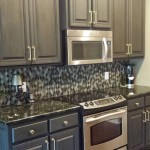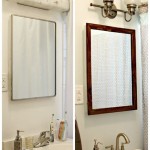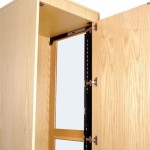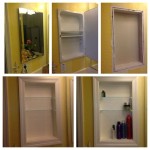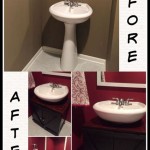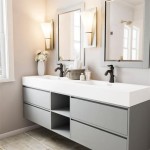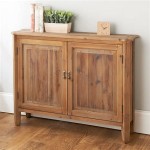Maximize Space With Drawers In Kitchen Cabinets
Kitchen space is often a premium, particularly in apartments or older homes. Optimizing storage solutions becomes essential for maintaining an organized and functional cooking environment. Among various options, integrating drawers within kitchen cabinets emerges as a highly effective strategy for maximizing space utilization and enhancing accessibility.
Traditional cabinet designs often rely on shelves, which, while functional, can lead to disorganized storage. Items at the back of the shelf can become difficult to reach, creating a "dead zone" where infrequently used items are forgotten. Drawers, on the other hand, offer a pull-out mechanism that allows for complete visibility and access to all stored items, regardless of their location within the cabinet.
The strategic implementation of drawers within kitchen cabinets can significantly improve the efficiency and ergonomics of the kitchen workspace. This approach addresses common storage challenges and contributes to a more streamlined and enjoyable cooking experience.
Increased Accessibility and Visibility
One of the primary advantages of incorporating drawers into kitchen cabinets is the enhanced accessibility they provide. Unlike fixed shelves, drawers can be fully extended, bringing all contents into view. This eliminates the need to reach deep into the cabinet, minimizing the risk of knocking over items or straining oneself to retrieve objects at the back. This is particularly beneficial for individuals with limited mobility or those who find it challenging to bend or reach.
The increased visibility afforded by drawers also contributes to better organization. Items are less likely to be hidden or forgotten, reducing the likelihood of duplicate purchases or food waste. Knowing what is available at a glance simplifies meal planning and grocery shopping. Furthermore, the ability to see all contents encourages a more proactive approach to cleaning and maintenance, preventing the accumulation of expired or unused items.
Consider the practical application of drawers for storing pots and pans. Instead of stacking them haphazardly on a shelf, drawers allow for individual placement, preventing scratches and dents. Each pot can be readily identified and retrieved without disturbing the others. Similarly, storing baking sheets and cutting boards vertically in a drawer with dividers maximizes space and avoids the cumbersome process of lifting them from a stack.
The ergonomic benefits of drawer systems extend beyond physical accessibility. Visual accessibility reduces mental clutter, creating a more calming and efficient kitchen environment. The ease of locating and retrieving items minimizes stress and frustration, allowing for a more enjoyable cooking experience.
The configuration of drawers can also be tailored to specific needs. Shallow drawers are ideal for storing utensils, cutlery, and small items like spice jars. Deeper drawers can accommodate larger items such as mixing bowls, serving dishes, and even small appliances. The flexibility inherent in drawer design allows for customized storage solutions that cater to individual preferences and cooking habits.
Optimized Space Utilization
Drawers, when properly designed and implemented, can significantly optimize the use of available space within kitchen cabinets. Unlike shelves, which often leave unused vertical space above items, drawers can be configured to maximize the available height. This is particularly evident when utilizing drawers with adjustable dividers or inserts, which allow for the compartmentalization of items and the prevention of wasted space between them.
The depth of drawers can also be customized to suit specific storage needs. Full-extension drawers utilize the entire depth of the cabinet, eliminating the "dead zone" that often exists at the back of shelves. This ensures that all available space is used efficiently, maximizing storage capacity. Furthermore, the consistent depth of drawers promotes a more uniform and organized appearance within the cabinet interior.
Consider the example of base cabinets, which often have limited accessibility due to their location low to the ground. Replacing shelves with drawers in base cabinets significantly improves the usability of this space. Heavy items such as canned goods or cookware can be stored in drawers without the need to bend or kneel to retrieve them. This not only enhances convenience but also reduces the risk of injury.
Corner cabinets, often a challenge to organize effectively, can also benefit from the integration of drawers. Specialty drawers, such as lazy susan drawers or pull-out shelves with integrated drawers, can transform these awkward spaces into highly functional storage areas. These innovative drawer solutions allow for easy access to items stored in the corners of the cabinet, eliminating the need to rummage through cluttered shelves.
The concept of vertical storage is also enhanced through drawer systems. Tall pantry cabinets can be equipped with a series of drawers, allowing for the organization of food items by type or expiration date. This system ensures that all items are visible and accessible, minimizing food waste. Similarly, vertical drawers can be used to store cleaning supplies, linens, or other household items, maximizing the use of available space.
The efficient use of space afforded by drawers also contributes to a more streamlined and organized kitchen overall. By maximizing storage capacity within cabinets, drawers can help to reduce clutter on countertops and other surfaces, creating a more spacious and inviting cooking environment. This, in turn, promotes a more enjoyable and efficient cooking experience.
Enhanced Organization and Customization
Drawers offer a significant advantage in terms of organization and customization compared to traditional shelving. The ability to compartmentalize items within drawers allows for a more structured and efficient storage system. This is particularly beneficial for organizing small items, such as utensils, spices, or cutlery, which can easily become disorganized on shelves.
Drawer dividers are a key component of effective drawer organization. These dividers can be adjusted to create compartments of various sizes, allowing for the tailored storage of different items. Adjustable dividers are particularly useful for organizing cutlery or utensils, ensuring that each item has its designated place. Fixed dividers can also be used to create permanent compartments for specific items, such as spices or baking ingredients.
Drawer inserts, such as spice racks, knife blocks, or pot lid organizers, can further enhance the organization and functionality of drawers. These inserts are designed to fit neatly inside drawers, providing dedicated storage for specific items. Spice racks, for example, allow for the organization of spices by type or expiration date, making it easy to locate the desired spice when needed.
The ability to customize drawer configurations is another significant advantage. Drawer depths, widths, and heights can be tailored to suit specific storage needs. Shallow drawers are ideal for storing utensils or cutlery, while deeper drawers can accommodate larger items such as mixing bowls or pots and pans. The flexibility inherent in drawer design allows for the creation of a storage system that is perfectly tailored to individual needs and preferences.
Labeling drawers is an effective way to further enhance organization. Labels can be used to identify the contents of each drawer, making it easy to locate items quickly and efficiently. This is particularly useful for drawers that contain a variety of items or for households with multiple cooks. Clear and concise labels can significantly improve the overall organization and functionality of the kitchen.
The organized nature of drawer systems also promotes a more efficient and enjoyable cooking experience. By providing designated storage for all items, drawers eliminate the need to rummage through cluttered shelves in search of ingredients or utensils. This saves time and effort, allowing for a more focused and productive cooking session. Furthermore, the organized appearance of drawers contributes to a more calming and inviting kitchen environment.
Beyond practical considerations, drawer fronts can also be customized to match the overall aesthetic of the kitchen. A wide range of materials, finishes, and styles are available, allowing for the selection of drawer fronts that complement the existing cabinetry. This ensures that the integrated drawer system seamlessly blends into the overall design of the kitchen, enhancing its visual appeal.
In conclusion, the strategic implementation of drawers within kitchen cabinets offers a multitude of benefits, including increased accessibility, optimized space utilization, and enhanced organization. This approach addresses common storage challenges and contributes to a more streamlined, efficient, and enjoyable cooking experience.

How To Maximize Storage With Innovative Kitchen Cabinet Designs North East Ohio The Floor King

Maximize Your Kitchen Storage In Denver With Custom Cabinets Creations

5 Cool Kitchen Storage Ideas Solutions Maximize Space

Kitchen Cabinet Ideas To Maximize Storage Space Rta Wood Cabinets

Your Cramped Kitchen Local Designer Shares Creative Ways To Add More Storage Space Palo Alto

How To Plan Your Kitchen Storage For Maximum Efficiency

20 Kitchen Storage Ideas Extra Space

How To Make The Most Of A Small Kitchen Wolf Home S

Maximize Kitchen Cabinet Space A Guide To An Organized

Maximize Cabinet Space Storage Solutions For All Spaces
Related Posts

